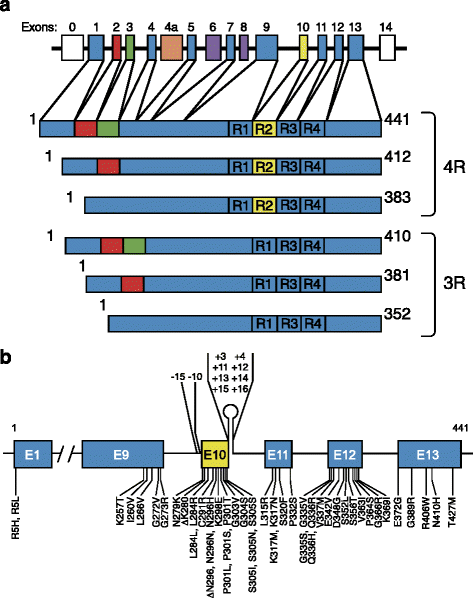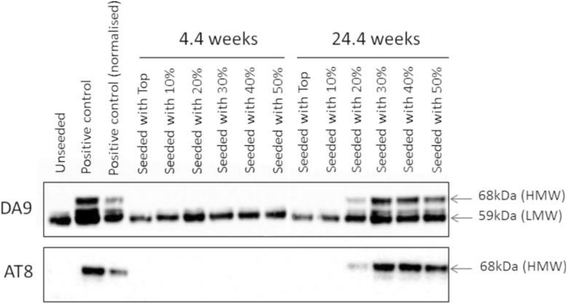Propagation of Tau aggregates
- PMID: 28558799
- PMCID: PMC5450399
- DOI: 10.1186/s13041-017-0298-7
Propagation of Tau aggregates
Abstract
Since 2009, evidence has accumulated to suggest that Tau aggregates form first in a small number of brain cells, from where they propagate to other regions, resulting in neurodegeneration and disease. Propagation of Tau aggregates is often called prion-like, which refers to the capacity of an assembled protein to induce the same abnormal conformation in a protein of the same kind, initiating a self-amplifying cascade. In addition, prion-like encompasses the release of protein aggregates from brain cells and their uptake by neighbouring cells. In mice, the intracerebral injection of Tau inclusions induced the ordered assembly of monomeric Tau, followed by its spreading to distant brain regions. Short fibrils constituted the major species of seed-competent Tau. The existence of several human Tauopathies with distinct fibril morphologies has led to the suggestion that different molecular conformers (or strains) of aggregated Tau exist.
Keywords: Alzheimer’s disease; Amyloid; Cell-to-cell spreading; Disease propagation; Prion-like; Protein strains; Tau; Tauopathies.
Figures



Similar articles
-
Propagation of Tau Aggregates and Neurodegeneration.Annu Rev Neurosci. 2017 Jul 25;40:189-210. doi: 10.1146/annurev-neuro-072116-031153. Annu Rev Neurosci. 2017. PMID: 28772101 Review.
-
The ordered assembly of tau is the gain-of-toxic function that causes human tauopathies.Alzheimers Dement. 2016 Oct;12(10):1040-1050. doi: 10.1016/j.jalz.2016.09.001. Epub 2016 Sep 26. Alzheimers Dement. 2016. PMID: 27686274 Review.
-
Development of a novel tau propagation mouse model endogenously expressing 3 and 4 repeat tau isoforms.Brain. 2022 Mar 29;145(1):349-361. doi: 10.1093/brain/awab289. Brain. 2022. PMID: 34515757
-
Tau filaments in neurodegenerative diseases.FEBS Lett. 2018 Jul;592(14):2383-2391. doi: 10.1002/1873-3468.13108. Epub 2018 Jul 6. FEBS Lett. 2018. PMID: 29790176 Review.
-
[The proceeding of drug development based on the propagation of tau protein].Nihon Rinsho. 2016 Mar;74(3):432-7. Nihon Rinsho. 2016. PMID: 27025082 Japanese.
Cited by
-
Therapeutic antibody targeting microtubule-binding domain prevents neuronal internalization of extracellular tau via masking neuron surface proteoglycans.Acta Neuropathol Commun. 2019 Aug 7;7(1):129. doi: 10.1186/s40478-019-0770-y. Acta Neuropathol Commun. 2019. PMID: 31391090 Free PMC article.
-
Novel chemical inhibitor against SOD1 misfolding and aggregation protects neuron-loss and ameliorates disease symptoms in ALS mouse model.Commun Biol. 2021 Dec 15;4(1):1397. doi: 10.1038/s42003-021-02862-z. Commun Biol. 2021. PMID: 34912047 Free PMC article.
-
The elusive tau molecular structures: can we translate the recent breakthroughs into new targets for intervention?Acta Neuropathol Commun. 2019 Mar 1;7(1):31. doi: 10.1186/s40478-019-0682-x. Acta Neuropathol Commun. 2019. PMID: 30823892 Free PMC article. Review.
-
Tau-targeting therapies for Alzheimer disease.Nat Rev Neurol. 2018 Jul;14(7):399-415. doi: 10.1038/s41582-018-0013-z. Nat Rev Neurol. 2018. PMID: 29895964 Free PMC article. Review.
-
Glycosaminoglycans in Neurodegenerative Diseases.Adv Exp Med Biol. 2021;1325:189-204. doi: 10.1007/978-3-030-70115-4_9. Adv Exp Med Biol. 2021. PMID: 34495536 Review.
References
Publication types
MeSH terms
Substances
Grants and funding
LinkOut - more resources
Full Text Sources
Other Literature Sources
Medical

